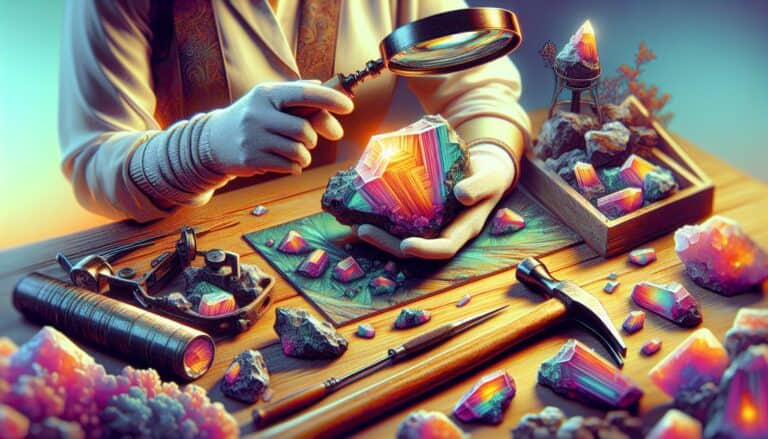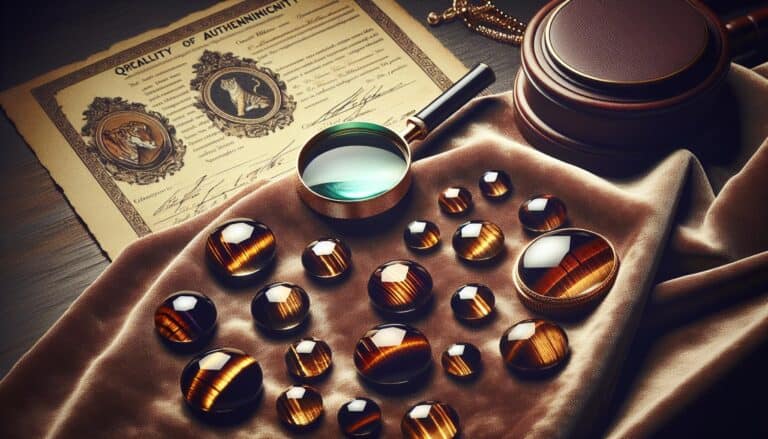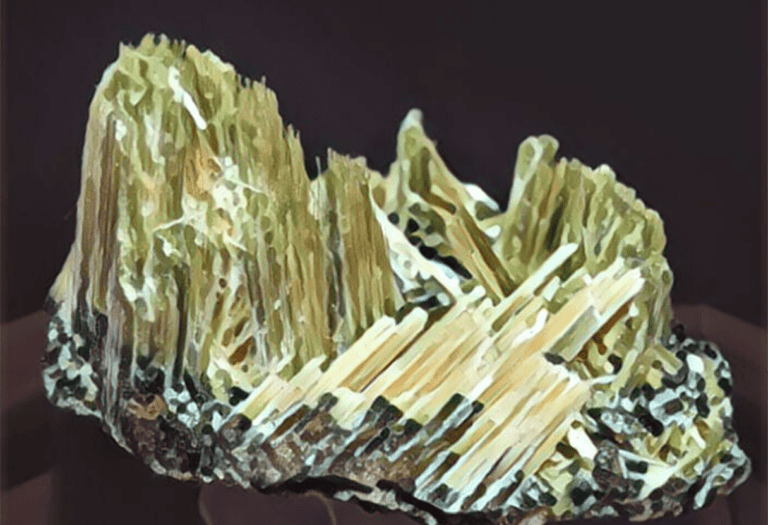Discovering the secrets of demantoid garnet isn’t just for gem enthusiasts—it’s a treasure hunt you can embark on too.
Known for its dazzling green hues and fiery brilliance, it stands out in the gemstone world. But how do you tell if you’ve struck gold—or rather, green—with a true demantoid garnet?
You’re about to learn the key characteristics that set demantoid garnets apart from other gems. From its unique inclusions to its distinctive color spectrum, you’ll be equipped to identify a genuine demantoid with confidence.
Whether you’re a collector, a jeweler, or simply a lover of beautiful stones, this knowledge is your first step into the sparkling world of demantoids.
Unveil the secrets of demantoid garnet with its vibrant green hues, fiery brilliance, and telltale horsetail inclusions. Check for white streak, slight magnetism, and 6.5-7 Mohs hardness. Single refraction, specific gravity around 3.8-3.9, and careful cleaning/storage ensure its lasting beauty.
How to Identify Demantoid Garnet Through Testing
Identifying a demantoid garnet requires a blend of visual scrutiny and scientific testing. Let’s break down some reliable methods to ascertain if you’ve got the real gem.
Visual Inspection
Begin with a Visual Inspection under a strong light. Check for the characteristic green color ranging from a vibrant grass green to a deep emerald hue. Authentic demantoid garnets often display fiery rainbow-colored sparks—a phenomenon known as dispersion. Look closely for horsetail inclusions, which are distinctive, needle-like features often present in natural demantoid garnets.
The Streak Test
Perform the streak test by rubbing the gem across an unglazed porcelain tile. A genuine demantoid garnet will leave a soft white streak. Remember, this test can be abrasive, so use it as a last resort to avoid potential damage to the stone.
Magnet Test
Use a strong magnet to check for magnetic properties. Demantoid garnets often contain ferric iron, making them slightly magnetic. If the stone is attracted to a magnet, it could be an indicator of its authenticity.
Hardness Test
Conduct a hardness test. Demantoid garnets rate between 6.5 and 7 on the Mohs hardness scale. They should be able to scratch substances like glass without being scratched by materials of lesser hardness.
Birefringence Test
Under polarized light, observe the stone for birefringence. While most garnets, including demantoid, are isotropic and show no birefringence, a careful examination could help in differentiating them from other green gemstones.
Checking The Diaphaneity
Examine the diaphaneity—that is, how transparent the gem is. Demantoid garnets typically range from transparent to translucid, another distinct trait to lookout for.
Single or Double Refraction
Demantoid garnets are singly refractive; when you look through them, there should be no doubling of lines or patterns beneath. Confusion may arise with doubly refractive stones, but this test helps in negating such possibilities.
Refractive Index Test
Perform a refractive index test using a refractometer. Demantoid garnets have a refractive index from 1.880 to 1.889. Any readings outside this range suggest the gem might not be genuine.
Finding The Specific Gravity
Measure the specific gravity which for demantoid garnets should be approximately 3.8 to 3.9. Checking this can help distinguish demantoid from other garnets and simulants, especially when other tests are inconclusive.
Identifying Demantoid Garnet in the Field
In the field, look for rough stones with characteristic green color. Note the surrounding rock as demantoids are typically found in schists and serpentinites.
Recognizing Potential Demantoid Garnet Rocks
Recognizing potential demantoid garnet host rocks is crucial. Keep an eye out for dark-colored serpentine rocks, which often house these precious gems. Presence of chromium within the rock could be an indicator of potential demantoid garnets.
By familiarizing yourself with these tests and observations, you’ll be well-equipped to identify a true demantoid garnet. As you go through these steps, remember that each test contributes crucial information, building a case for—or against—the stone’s authenticity.
Physical Characteristics of Demantoid Garnet

When you’re on the hunt for demantoid garnets, knowing the physical characteristics can make a world of difference. Demantoid garnets are renowned for their rich, vivid green hue, which can range from a deep forest green to a light, almost yellow-green, often described as bottle-green or emerald-like. This wide color spectrum is influenced by varying levels of iron content.
- Luster: Demantoids possess an exceptional luster, presenting a vitreous to slightly resinous shine that adds to their visual appeal.
- Hardness: They score between 6.5 and 7 on the Mohs scale, indicative of reasonable durability for jewelry.
- Dispersion: An aspect that sets demantoids apart is their high dispersion rate, which exceeds even that of diamonds. This means they exhibit a remarkable brilliance and fire when cut correctly.
Understanding these aspects, it’s also worth noting that these gems often contain horsetail inclusions, which are fine, feathery inclusions radiating from a central point. These are not only characteristic of this variety but can also enhance its value. In the gemstone world, size also matters; demantoid garnets are typically found in smaller sizes, with stones larger than 2 carats being relatively rare.
The density of demantoid garnet is another distinguishing feature, with these gems having a specific gravity ranging from 3.82 to 3.85. When you’re evaluating potential specimens, this detail can help you differentiate demantoid from similar gemstones.
Armed with knowledge about these distinctive qualities, you’ll be well-equipped to spot the real deal. Remember to examine stones under different lighting conditions to fully appreciate their color and luster. Keep an eye out for those unique horsetail inclusions, as they’re often a telltale sign of authenticity.
How Are Demantoid Garnet Formed?
Demantoid garnets are formed deep within the Earth’s crust under high-pressure and high-temperature conditions. They’re a variety of the mineral andradite, which is a member of the larger garnet group. Their formation process is complex and involves geological changes that take place over millions of years.
The Geological Journey
To truly appreciate the value of demantoid garnets, you’ll want to understand the unique conditions that lead to their creation. These gemstones begin as a mix of elements, including:
- Silicon
- Oxygen
- Iron
Over time, these elements are subjected to intense heat and pressure, causing them to crystalize into the beautiful stones highly sought after today.
Rare Circumstances for a Rare Gem
The rarity of demantoid garnets stems from the specific conditions required for their formation. Typically, these garnets form in areas with:
- Metamorphic Rocks: They are often found in association with serpentinites, schists, and other rock types transformed by heat and pressure.
- Ultramafic Rocks: The presence of iron-rich ultra-basic rocks provides the necessary iron for the garnets to form.
It’s these demanding environmental factors that contribute to the demantoid garnet’s scarcity and value. As you continue your journey into the depths of gemology, you’ll find that each demantoid’s unique birthmarks, like its horsetail inclusions, tell a rich story of the arduous conditions that shaped them.
Preparation for Demantoid Garnet Hunting
Gathering the Right Tools
Before you head out on your demantoid garnet hunting adventure, it’s essential to gather the right tools. Quality equipment can make the difference between a fruitful search and a futile one.
- Geologist’s hammer or pick: This will be your primary tool for chiseling and breaking rocks to reveal any potential gemstones.
- Safety glasses: Protecting your eyes from flying debris is crucial during rock breaking.
- Gloves: Durable gloves will guard your hands against sharp edges and provide a better grip.
- Trowel: Useful for digging around in softer sediment.
- Tweezers: These will help you pick up small garnets without causing damage.
- Bucket or pouch: You’ll need something to hold your finds as you continue your search.
Remember, while high-tech gadgets can be helpful, they’re not always necessary. Trust in your knowledge, skills, and the quality of these basic tools to guide you in your quest for demantoid garnets.
Safety Considerations
When searching for demantoid garnets, your safety should be the top priority. The environments where these gemstones are found can be treacherous, and being prepared can prevent accidents.
- Wear protective clothing: Long sleeves, pants, and boots can protect against scratches and bites from insects or animals.
- Research the area: Know the climate, terrain, and wildlife of the region where you’ll be hunting.
- Stay hydrated: Bring plenty of water, especially if you’re searching in a hot or dry area.
- Inform someone: Always let someone know where you’re going and when you expect to return.
- First aid kit: Accidents happen, so be ready with bandages, antiseptic, and other basic first aid supplies.
By adhering to these safety considerations, you’ll be able to focus on the thrill of the hunt without putting yourself at unnecessary risk. Remember, no gemstone is worth compromising your well-being.
Handling and Care of Found Demantoid Garnet

After you’ve had a successful day hunting for demantoid garnets, knowing how to handle and care for your finds is crucial. These gems require particular attention to maintain their luster and value. Let’s delve into the best practices for cleaning and storing your demantoid garnets to ensure their longevity.
Cleaning Demantoid Garnets
Cleaning demantoid garnets might seem straightforward, but it’s important to proceed with caution to avoid damaging these precious stones. Always use a soft brush and warm, soapy water to gently remove any dirt or debris. Avoid using harsh chemicals or ultrasonic cleaners as they can damage the gem’s surface.
Begin by preparing a solution of mild dish soap and warm water. Submerge your gemstones in this solution for a few minutes, and then, using a soft-bristled brush like a toothbrush, gently scrub the stones to remove any clinging soil or grit. Rinse the stones thoroughly with clean water to wash away any soap residue.
Once clean, pat the garnets dry with a soft cloth and allow them to air dry completely. Ensure they’re fully dry before storing to prevent any moisture from getting trapped, which could lead to damage or the growth of mildew over time.
Storing Demantoid Garnets
Storing your demantoid garnets correctly is just as important as cleaning them. These gems should be kept away from direct sunlight and extreme temperatures, which could cause them to fade or crack. Ideally, you’ll want to store your garnets in a cool, dark place.
To prevent scratching or chipping, wrap individual stones in a soft cloth or place them in a fabric-lined jewelry box. If you have a collection of gemstones, consider using a dedicated storage box with separate compartments for each gem to keep them from knocking against each other.
In addition to physical protection, keeping your garnets in an environment with stable humidity is vital. Extreme changes in moisture can affect the integrity of the stones. If necessary, a silica pack can be included in the storage space to control moisture levels.
Remember that while demantoid garnets are fairly durable, they still require gentle handling. Never place heavy objects on top of your stored garnets and be mindful of not exposing them to sharp impacts which could lead to fractures. By following these steps, your demantoid garnets will remain dazzling for years to come.
Conclusion: Confirming Demantoid Garnet is Real
You’ve learned how to identify the lustrous demantoid garnet and understand the importance of handling and caring for this precious gem.
Remember, gentle cleaning and proper storage are key to preserving its brilliance. Trust your newfound knowledge and enjoy the beauty of your demantoid garnet for years to come.
Keep these tips in mind and your gem will continue to sparkle with that distinctive fire that sets it apart from other stones.



![Texas Rockhounding Sites in [year]: What You’ll Discover & Where](https://observationhobbies.com/wp-content/uploads/2024/01/MZHIzqyqCDorVgqMLNsPb-768x439.jpg)



